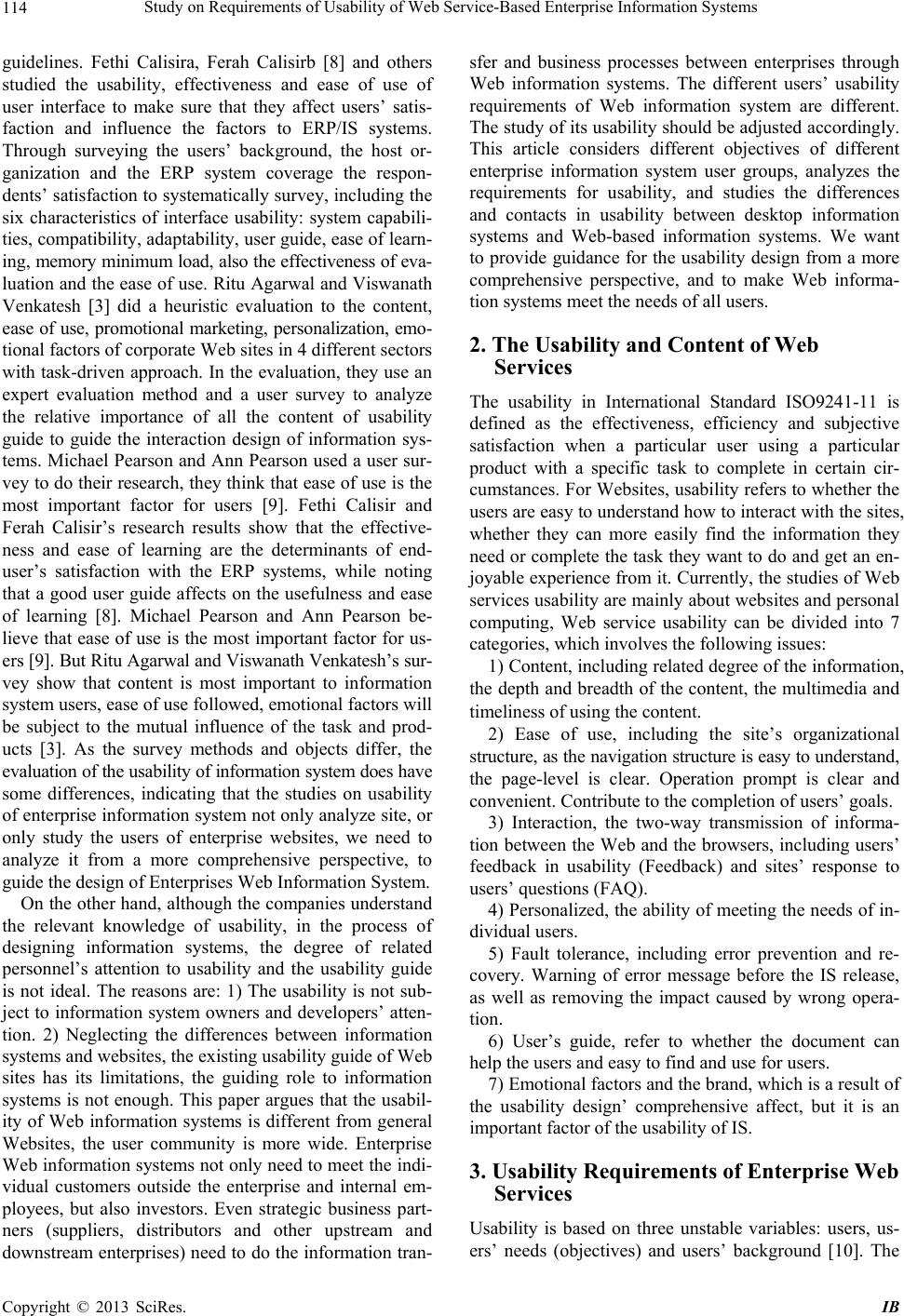
Study on Requirements of Usability of Web Service-Based Enterprise Information Systems
114
guidelines. Fethi Calisira, Ferah Calisirb [8] and others
studied the usability, effectiveness and ease of use of
user interface to make sure that they affect users’ satis-
faction and influence the factors to ERP/IS systems.
Through surveying the users’ background, the host or-
ganization and the ERP system coverage the respon-
dents’ satisfaction to systematically survey, including th e
six characteristics of interface usability: system capabili-
ties, compatibility, adaptability, user guide, ease of learn-
in g, memor y minimu m load, a lso the effectiveness of eva-
luation and the ease of use. Ritu Agarwal and Viswanath
Venkatesh [3] did a heuristic evaluation to the content,
ease of use, promotional marketing, personalization, emo-
tional factors of corporate Web sites in 4 different sectors
with task-driven approach. In the evaluation, they use an
expert evaluation method and a user survey to analyze
the relative importance of all the content of usability
guide to guide the interaction design of information sys-
tems. Michael Pearson and Ann Pearson used a user sur-
vey to do their research, they think th at ease of use is the
most important factor for users [9]. Fethi Calisir and
Ferah Calisir’s research results show that the effective-
ness and ease of learning are the determinants of end-
user’s satisfaction with the ERP systems, while noting
that a good user guide affects on the usefulness and ease
of learning [8]. Michael Pearson and Ann Pearson be-
lieve that ease of use is the most important factor for us-
er s [9]. But Ritu Agarwal and Viswanath Venkatesh’s sur-
vey show that content is most important to information
system users, ease of use followed, emotional factors will
be subject to the mutual influence of the task and prod-
ucts [3]. As the survey methods and objects differ, the
evaluation of the usability of information system does have
some differences, indicating that the studies on usability
of enterprise information system not only analyze site, or
only study the users of enterprise websites, we need to
analyze it from a more comprehensive perspective, to
guide the design of Enterprises Web Information System.
On the other hand, although the companies understand
the relevant knowledge of usability, in the process of
designing information systems, the degree of related
personnel’s attention to usability and the usability guide
is not ideal. The reasons are: 1) The usability is not sub-
ject to information system owners and developers’ atten-
tion. 2) Neglecting the differences between information
systems and websites, the existing usab ility guide of Web
sites has its limitations, the guiding role to information
systems is not enough. This paper argues that the usabil-
ity of Web information systems is different from general
Websites, the user community is more wide. Enterprise
Web information systems not only need to meet the indi-
vidual customers outside the enterprise and internal em-
ployees, but also investors. Even strategic business part-
ners (suppliers, distributors and other upstream and
downstream enterprises) need to do the informatio n tran-
sfer and business processes between enterprises through
Web information systems. The different users’ usability
requirements of Web information system are different.
The study of its usability should be adjusted accordingly.
This article considers different objectives of different
enterprise information system user groups, analyzes the
requirements for usability, and studies the differences
and contacts in usability between desktop information
systems and Web-based information systems. We want
to provide guidance for the usability design from a more
comprehensive perspective, and to make Web informa-
tion systems meet the needs of all users.
2. The Usability and Content of Web
Services
The usability in International Standard ISO9241-11 is
defined as the effectiveness, efficiency and subjective
satisfaction when a particular user using a particular
product with a specific task to complete in certain cir-
cumstances. For Websites, usability refers to whether the
users are easy to understand how to interact with the sites,
whether they can more easily find the information they
need or complete the task th ey want to do and get an en-
joyable experience from it. Currently, the studies of Web
services usability are mainly abou t websites and person al
computing, Web service usability can be divided into 7
categories, which involves the following issues:
1) Content, including related degree of the information,
the depth and breadth of the content, the multimedia and
timeliness of using the content.
2) Ease of use, including the site’s organizational
structure, as the navigation structure is easy to understand,
the page-level is clear. Operation prompt is clear and
convenient. Contribute to the completion of users’ goals.
3) Interaction, the two-way transmission of informa-
tion between the Web and the browsers, including users’
feedback in usability (Feedback) and sites’ response to
users’ questions (FAQ).
4) Personalized, the ability of meeting the needs of in-
dividual users .
5) Fault tolerance, including error prevention and re-
covery. Warning of error message before the IS release,
as well as removing the impact caused by wrong opera-
tion.
6) User’s guide, refer to whether the document can
help the users and easy to find and use for users.
7) Emotional factors and the brand, which is a result of
the usability design’ comprehensive affect, but it is an
important factor of the usability of IS.
3. Usability Requirements of Enterprise Web
Services
Usability is based on three unstable variables: users, us-
ers’ needs (objectives) and users’ background [10]. The
Copyright © 2013 SciRes. IB